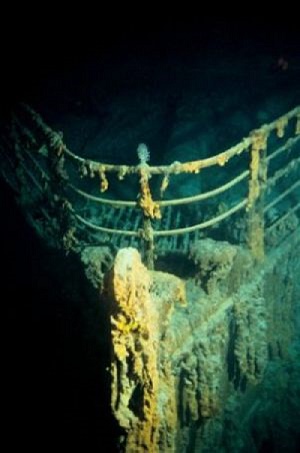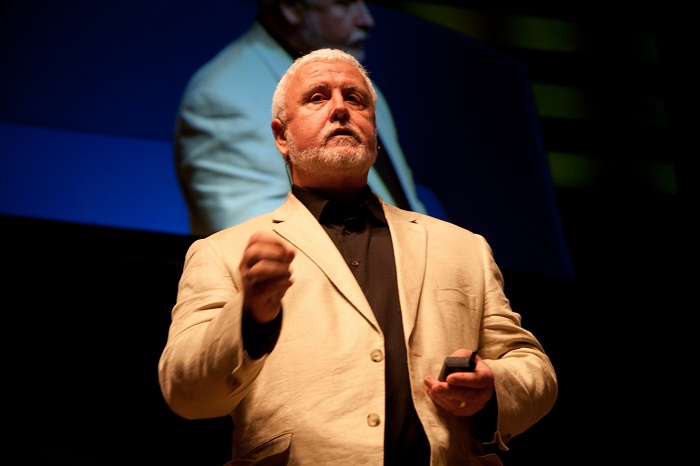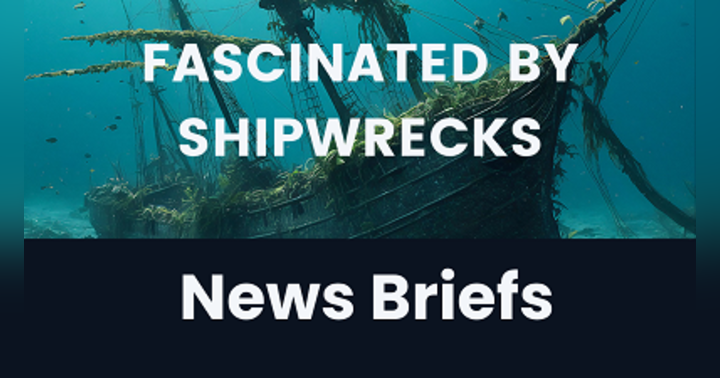Charting the Depths: James Delgado’s Extraordinary Career

James Delgado diving with Mark Polzer on the Phoenician shipwreck at Bajo de la Campana, Spain. Credit: Patrick Baker
When it comes to uncovering the secrets of shipwrecks, few names carry the weight and respect of James Delgado. With more than 150 investigations under his belt, including famous wrecks like Titanic, USS Arizona, and Clotilda, Delgado is a towering figure in the world of maritime archaeology. He joined Fascinated by Shipwrecks podcast, host Kathy A. Smith, for three inaugural episodes to discuss his extraordinary career, the evolution of maritime archaeology, and the shipwrecks that have made a profound impact on his life. This is a compilation of highlights from those episodes.
Humble Beginnings
Delgado’s career in maritime archaeology is rooted in childhood experiences far from the ocean floor. Raised initially by his grandparents, he describes himself as “a man out of time,” shaped by the values of an older generation. His fascination with history blossomed in grade school, inspired by tales of ancient civilizations. Living in what would become Silicon Valley, he watched development projects unearth Indigenous burials; disturbing scenes that drove him to action.
Armed with a copy of The Young Archaeologist’s Handbook, Delgado began his first rescues, ultimately helping recover remains of the Ohlone people. But his course shifted in 1978 when, as a young employee of the National Park Service, he watched the Gold Rush-era ship Niantic emerge from landfill in downtown San Francisco. It was a profound moment that drew him to the maritime world, and his path was set.
The Birth of an Industry
The roots of modern maritime archaeology trace back to the groundbreaking work of George Bass and his colleagues in the mid-20th century. Their scientific methods, developed during early underwater excavations off the coast of Turkey, laid the foundation for what has become a global and diverse field. Delgado emphasizes that it was a team effort, involving everyone from sponge divers to scholars. Today, maritime archaeology includes men and women from all cultures, and it has blossomed into a rich, collaborative discipline.
Delgado’s own journey began with scuba diving in the 1970s, but the field has since expanded far beyond human reach. “At this stage, five decades after I learned to dive, I really don’t scuba anymore,” he said. With many wrecks lying at extreme depths, today’s explorations often involve robotic vehicles and submersibles. While diving still plays a role, technological advances have made it safer and more accessible, especially for sites thousands of feet below the surface.
Delgado in the control van of E/V Nautilus during ROV dives on the wreck of the USS Independence, 2016. Credit: Julye Newlin, Ocean Exploration Trust
Now, while he still appreciates the tactile connection of jotting notes underwater, Delgado embraces the digital age. Photogrammetry, 3D modeling, and remotely operated vehicles (ROVs) now allow teams to survey deep-sea wrecks like the USS Stewart without human descent. In the Stewart investigation, a team worked from offices around the world, directing an ROV thousands of feet underwater. “We ran the dive as archaeologists but always with care,” he said. “First, you document. Do no harm.”
A Legacy of Shipwrecks
Over the span of his career, Delgado has led or participated in more than 150 shipwreck investigations, each with its own story, its own emotional weight. Some, like Titanic, capture the global imagination. Others, like the Clotilda, the last known slave ship to bring captives to the United States, profoundly change the narrative of history. Diving into the Clotilda’s hold, Delgado felt the magnitude of the atrocity etched into the ship’s timbers. “The pain of those descendants is magnified when you begin to understand that there were thousands of ships over hundreds of years and millions of people,” he said. “I’ll never get over that.”
Delgado speaking at the announcement of the identification of Clotilda in Africatown. Credit: Daniel Fore
Other wrecks speak to wartime sacrifice, such as USS Arizona, where fire hoses frozen in place tell of sailors vaporized mid-rescue. Or USS Conestoga, a U.S. Navy tug lost in 1921 and long considered missing until Delgado and his team at the National Oceanic and Atmospheric Administration (NOAA) found it, bringing long-awaited closure to families. Each wreck, he says, reveals something about our shared past, sometimes tragedy, sometimes triumph.
The Role of Citizen Scientists
One of the most powerful shifts Delgado has witnessed is the rise of citizen science. Volunteers around the world now contribute to archaeological projects, often bringing specialized skills in photography, marine biology, or local history. He points to the Underwater Archaeological Society of British Columbia (UASBC) as a prime example: These passionate contributors aren’t getting paid, they’re paying to be involved, which Delgado sees as the ultimate testament to their dedication.
The Explorer’s Heart
Delgado has traveled to nearly 100 countries, sailed every ocean, and stood at ground zero of nuclear tests in Bikini Atoll. He believes true exploration means returning with something to share. Whether it’s publishing a report, writing a book, or helping a younger colleague find their path, sharing knowledge is central to the mission.
“There’s very little that hasn’t been seen by others,” he said. “But it becomes exploration when you bring new understanding, when you come back and tell the story.” This is evidenced by the fact that Delgado has written over 37 books, more than 100 articles, has given countless academic and public lectures, and has participated as a leading expert on popular TV documentary series such National Geographics’ The Sea Hunters and Drain the Oceans.
Filming a segment for Drain the Oceans at the University of Delaware.
Revisiting Titanic
No conversation with Delgado would be complete without touching on the Titanic. Having participated in a pioneering 3D mapping project in 2010, he speaks of the wreck with awe and reverence. “Titanic was the disaster of the century,” he said. “It was the first modern media disaster, transmitted in real-time by wireless.”
But beyond its mythic status, Titanic tells human stories. One that particularly moved him was the recovery of Franz Pulbaum’s trunk. Inside were everyday items; boots, tools, a German-English dictionary, and a document of his declaration of intent to become a U.S. citizen. “That document was waiting to be read at Ellis Island,” Delgado reflected. “But he died in April 1912. His story would’ve been lost without that trunk.”
As Titanic continues to decay, Delgado believes future missions should focus not on salvaging relics, but on storytelling. “If anything more comes up, it should be something like Franz’s trunk,” he said. “Because what we do as archaeologists isn’t just about planks or rivets, it’s about what these ships tell us about ourselves.”

Advice for the Next Generation
To those interested in the path of becoming a maritime archaeologist, Delgado offers clear guidance: follow your passion, stay curious, and be ready to adapt. “You may chart one course and find yourself pulled to a new one,” he explained. “That’s okay. Sail it anyway.”
He emphasizes the importance of reading, whether physical books or digital articles as a lifelong companion to learning. “You never know enough, and you never stop learning,” he says, a sentiment strengthened by his marriage to a librarian and his own vast collection of maritime history books.
But most of all, he urges collaboration over competition. “The Earth is a single ship moving through the vastness of space,” he said. “And there are no lifeboats. We’re in this together.”
A Lasting Legacy
Now in the later stages of his career—over 50 years since his first archaeological dig—Delgado shows no signs of slowing down. He continues to work on new projects, write, mentor, and advocate for ethical exploration. One of the most meaningful parts of this phase, he says, is working with the next generation.

“I’m at a point where I can help younger colleagues,” he said. “And that’s the best part. Years ago, I was told that to truly pay back what you were given, you have to pay it forward. I believe in that.”
In the end, Delgado’s story is not just about shipwrecks. It’s about honouring memory, inspiring discovery, and shaping how we understand the maritime thread that runs through human history. It’s a reminder that in the silent depths of the ocean, there are voices still waiting to be heard, and skilled storytellers like Delgado who bring them to light.

Want more fascinating stories from the deep?
Catch all three interviews with James Delgado on the Fascinated by Shipwrecks podcast.
Listen or watch anytime. You'll see more photos in the video versions!
Episode 1: Underwater Exploration: The Legacy of Titanic
Episode 2: Sailing the Seven Seas, Citizen Science, and the USS Stewart
Episode 3: History, Tragedy, and Humanity
Purchase Jim's new book: The Great Museum of the Sea: A Human History of Shipwrecks
© 2025 Fascinated by Shipwrecks









